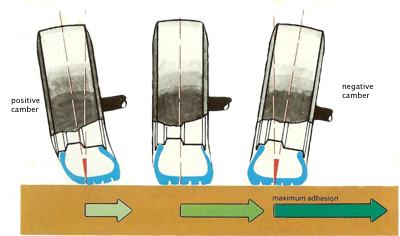Well, you can see in the garage that camber affects the visuals. But, if there is a bug, the physical could be pointed at the sky for all we know. Or as I posted in the other thread, it could be rotating on the wrong axis.
I still find this debate interesting because of the passionate pursuit of being correct.
OK, here comes a blurb from "Team Viejo", the oldest replica racer on GT6. (that would be me)
Long ago and far away, in Mustangworld, I decided to make my 96 SVT Cobra into a race/rally/track car, and barely managed to keep it street legal. After spending around 25,000 USDollars on suspension alone, the car began to handle so well, that Porches and Vipers and other hot cars would be staring in their rearview mirrors at the very close front end of my Mustang, in the corners!!!. (Had a Cobra R hood too!)
Basically, the stock suspension was thrown away and rebuilt from the ground up. Gee, this sounds familiar to us GT guys doesn't it? The front end was converted into true Macpherson strut suspension with coil-over Konis, adjustable ride height, with guess what, Caster/camber plates, that allowed adjustment of both caster and camber. The strut towers were impressively braced across the car and rearward to the firewall. The engine mounts were replaced with a tubular cradle unit that locked everything together and the steering ram was remounted with aluminum bushings for solid steering. Needless to say the moncoque frame was extensively beefed up, all the way out to the door sills with diagonal bracing. This became a stiff car. I got clued in to all this stuff while having Steve Saleen drive my stock Cobra around Seattle Intl Raceway. FOR FIVE LAPS!! I told him to "Go for it, the engine is Bulletproof" and did he ever!?!? I thought we were inside of a beached whale, the guy is a maniac!!! And the car was ridiculous!
Having access to camber was very beneficial in open track work and adding 2.5 degrees (negative) was optimal for smoking the Porches and Vipers. I was running Firestone SZ-50's which were actually built in the Bridgestone factory in Japan. These were equivalent to our Sport Soft tires with a speed limit of 160 mph.
The other thing that I loved doing was the Silver State Classic Series of rallies in Nevada. This is where they block off about 100 miles of PUBLIC ROAD and run the race/rally for about 8 hours. In the main event, the road was a series of straights, linked by corners that could be taken flat out to about 180 mph. Some of the straights were close to 14 miles long!! Shades of Route X! For this event, all that camber would not be required, so I would back off the camber to -0.5 degrees and swing the caster(the top of the struts) back to 9 degrees which is Mercedes country!! This made the car super stable at speed and still alowed decent cornering. Mercedes run a lot of caster because they are made to run well over 100 mph on the German Autobahns. They are not twitchy at speed and neither was my Mustang.
Just in case anybody cares, the rear suspension of my Mustang was also changed with coil-overs overtop of Koni circle track dampers, adjustable ride height of course, and a torque arm from the differential pumpkin to a cross member midships and a panhard bar to anchor the axle laterally made the ass end like a rock when you pushed the back of the car across the axle! Suddenly a Mustang that would not spin out was born!!
I guess the point of this epistle is to emphasise the function and importance of both caster and camber in tuning a race car. It would be my dream that PD could impliment both of these tuning aids in GT-6 as per real life cars.
For me the fun thing about GT-6 is being able to tune without spending a bazillion real dollars and not getting very dirty and greasy at the same time. Oh, and being able to tune in hours instead of months.
Thank you for your attention, Mustangxr









 Jack is box office
Jack is box office 

